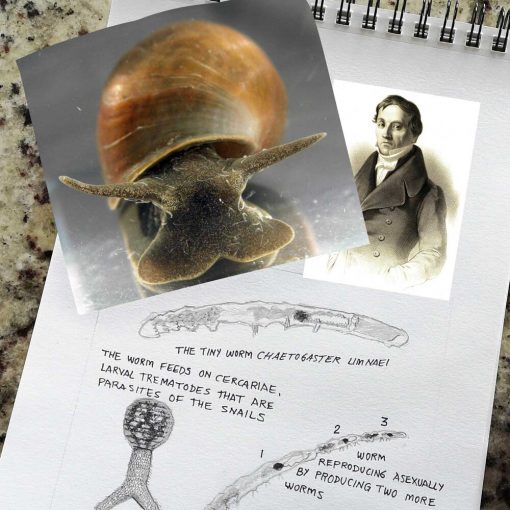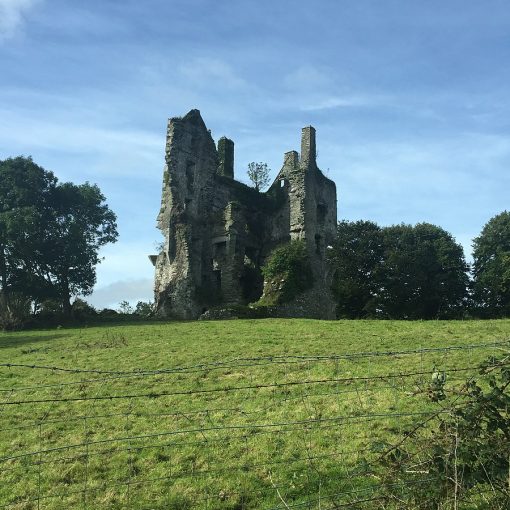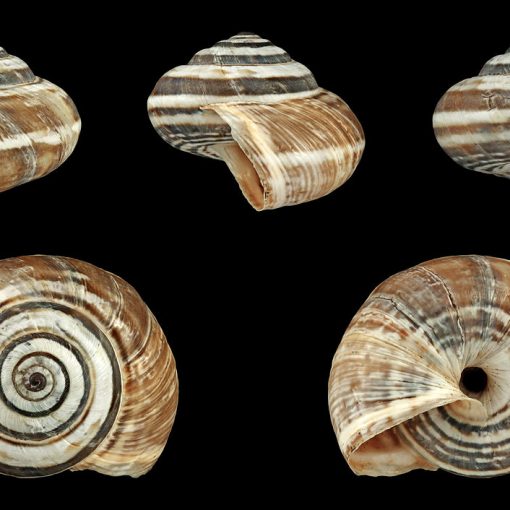Author: Julián Monge Nájera, Ecologist and Photographer
These mysterious worms hunt with an instantaneous net and many do not lay eggs, instead of giving birth to young that they feed through a placenta, just like mammals. They are known from fossils over 500 million years old and until recently, there was a heated debate about which animals were their closest relatives. But recent genetic analyses tell us who was right all along.
Velvet worms, or onychophorans, have interested evolutionary researchers since the 19th-century¹. Recent work by Laumer et al. (2019) ², while still far from conclusive, shows a tendency for three groups to appear close together in DNA analyses: onychophorans, arthropods, and tardigrades; and a bit less closely, nematodes and priapulids.
Let us take an imaginary look at how they came to be the animals that we know today, on the assumption that the work by Laumer et al. (2019) gives us a reliable view of their evolutionary history ².
By using, as the basis, the characters shared by the five groups, I think that their common ancestor lived in the ocean over 530 million years ago, in the early Cambrian. It probably was a very small worm, in the range of a few millimeters in length, with a cuticle that was molted when the animal grew and that could develop spines. The sensory organs —for chemicals, vision, and others— were concentrated on the front, forming ahead, and the brain was connected with the rest of the body by a ventral nerve cord. In both females and males, sexual and excretory organs opened in the rear (where the excretions did not interfere with the sensory organs). Digestion was done by a longitudinal tube aided by glands that connected to the front or mid of the digestive tract (Figure 1).

Figure 1. The evolutionary relationship of onychophorans, arthropods, tardigrades, nematodes, and priapulids according to Laumer et al. (2019) ². Sources: Priapulid, Nematode, Tardigrade, Velvet worm, Arthropod.
The first branch that evolved from this ancestor led to the priapulids, a small group of marine predatory worms that use their spiny prosome to feed and move in their burrows (we have early Cambrian fossils of Eximipriapulus globocaudatus, which was 1.4 cm long ³).
The second branching led to a far more successful group, the nematodes⁴, which practically have all kinds of diets and are found nearly everywhere, including the organs of other organisms (as parasites) and the deepest communities under the surface of the earth (Halicephalobus mephisto⁵).
Another branch of those early worms developed legs and gave origin to tardigrades, onychophorans, and arthropods. The branch that exploited miniaturization led to tardigrades, tiny aquatic animals that suck cell contents from plants or animals. They have eight stout, unjointed limbs, and their miniaturization makes specialized organs of circulation or respiration unnecessary; adaptation to their changing habitats resulted in spectacular resistance to extreme drying and low temperatures⁶.
The branch that exploited life in a larger body size led to onychophorans and arthropods, which over time would reach impressive sizes of 20 cm for onychophorans and 2.5 meters in arthropods (Jaekelopterus rhenaniae). Luckily, we have fossils that give us an idea of how they were. The early onychophorans were so small that they are barely visible to our naked eye; had bodies covered with sensory papillae, protective spines and plates; and probably were predators with a decent vision. They developed breathing tracheae and a dorsal heart to move the blood around. Originally, they had a few pairs of relatively long, unjointed legs, but when they moved to land, their bodies became longer and compensated this with a greater number of legs, still without joints and shorter, which allow them to move in a funny and unexpectedly efficient way⁷.
A group of their relatives went further in armoring and locomotion, developing over time the advanced exoskeletons and jointed legs of trilobites, shrimp, and insects⁸.
Today, over 530 million years later, the descendants of that early tiny worm fill the planet with a mind-boggling variety of shapes and behaviors, and will probably do so long after our species disappears.
*Edited by Katherine Bonilla y Carolina Seas.
Originally published in Blog Biología Tropical: 22 September 2020
REFERENCES
¹ Monge-Nájera, J. (2020). Onychophorology, the study of velvet worms, historical trends, landmarks, and researchers from 1826 to 2020 (a literature review). Uniciencia, 35(1), 210-230. DOI: 10.15359/ru.35-1.13
² Laumer, C. E., Fernández, R., Lemer, S., Combosch, D., Kocot, K. M., Riesgo, A., … & Giribet, G. (2019). Revisiting metazoan phylogeny with genomic sampling of all phyla. Proceedings of the Royal Society B, 286(1906), 20190831. DOI: 10.1098/rspb.2019.0831
³ Ma, X., Aldridge, R. J., Siveter, D. J., Siveter, D. J., Hou, X., & Edgecombe, G. D. (2014). A New Exceptionally Preserved Cambrian Priapulid From the Chengjiang Lagerstätte. New Chengjiang priapulid. Journal of Paleontology, 88(2), 371-384. DOI: 10.1666/13-082
⁴ Baliński, A., Sun, Y., & Dzik, J. (2013). Traces of marine nematodes from 470 million years old Early Ordovician rocks in China. Nematology, 15(5), 567-574. DOI: 10.1163/15685411-00002702
⁵ Borgonie, G., García-Moyano, A., Litthauer, D., Bert, W., Bester, A., van Heerden, E., Möller, C., Erasmus, M., & Onstott, T. C. (2011). Nematoda from the terrestrial deep subsurface of South Africa. Nature, 474(7349), 79–82. DOI: 10.1038/nature09974
⁶ Cooper, K. W. (1964). The first fossil tardigrade: Beorn leggi Cooper, from Cretaceous amber. Psyche, 71(2), 41-48. DOI: 10.1155/1964/48418
⁷ Monge-Nájera, J., & Hou, X. (2002). Disparity, decimation and the Cambrian» explosion»: comparison of early Cambrian and Present faunal communities with emphasis on velvet worms (Onychophora). Revista de Biología Tropical, 50(2), 823-841.
⁸ Daley, A. C., Antcliffe, J. B., Drage, H. B., & Pates, S. (2018). Early fossil record of Euarthropoda and the Cambrian Explosion. Proceedings of the National Academy of Sciences, 115(21), 5323-5331. DOI: 10.1073/pnas.1719962115





180 ideas sobre “Who are the closest relatives of velvet worms?”
buying prescription drugs in mexico online: mexican mail order pharmacies – mexico drug stores pharmacies
reputable mexican pharmacies online https://mexicaneasypharm.shop/# Mexican Easy Pharm
purple pharmacy mexico price list
buying prescription drugs in mexico online https://mexicaneasypharm.com/# Mexican Easy Pharm
medication from mexico pharmacy
buying from online mexican pharmacy https://mexicaneasypharm.shop/# mexico drug stores pharmacies
mexico pharmacies prescription drugs
https://cytpharm.shop/# Cyt Pharm
prednisone buy cheap
http://cytpharm.com/# Cyt Pharm
prednisone 50 mg tablet cost
https://kamapharm.com/# Kama Pharm
prednisone buy canada
http://kamapharm.com/# sildenafil oral jelly 100mg kamagra
prednisone 40mg
http://kamapharm.com/# Kamagra 100mg price
prednisone canada
http://cytpharm.com/# Cyt Pharm
30mg prednisone
https://kamapharm.com/# Kamagra tablets
prednisone generic brand name
https://kamapharm.shop/# Kama Pharm
1250 mg prednisone
https://cytpharm.com/# CytPharm
prednisone in canada
http://kamapharm.com/# Kamagra tablets
can you buy prednisone over the counter in mexico
https://dappharm.shop/# buy dapoxetine online
prednisone where can i buy
https://kamapharm.com/# Kama Pharm
purchase prednisone no prescription
http://farmabrufen.com/# Brufen senza ricetta
farmacia online senza ricetta
https://farmatadalitaly.com/# comprare farmaci online all’estero
farmacie online sicure
http://farmatadalitaly.com/# farmacia online piГ№ conveniente
farmaci senza ricetta elenco
comprare farmaci online all’estero http://farmaprodotti.com/# Farmacie on line spedizione gratuita
Farmacie online sicure
https://phmacao.life/# Visitors come from around the world to play.
Many casinos have beautiful ocean views.
https://phmacao.life/# High rollers receive exclusive treatment and bonuses.
Cashless gaming options are becoming popular.
http://jugabet.xyz/# Las aplicaciones mГіviles permiten jugar en cualquier lugar.
Many casinos provide shuttle services for guests.
http://phmacao.life/# Many casinos offer luxurious amenities and services.
The casino scene is constantly evolving.
http://phtaya.tech/# Resorts provide both gaming and relaxation options.
The casino industry supports local economies significantly.
https://phmacao.life/# Players often share tips and strategies.
п»їCasinos in the Philippines are highly popular.
https://winchile.pro/# Las aplicaciones mГіviles permiten jugar en cualquier lugar.
Players enjoy a variety of table games.
http://taya777.icu/# The thrill of winning keeps players engaged.
The Philippines has several world-class integrated resorts.
https://phmacao.life/# Visitors come from around the world to play.
The ambiance is designed to excite players.
http://taya365.art/# The ambiance is designed to excite players.
Gambling can be a social activity here.
https://phmacao.life/# The gaming floors are always bustling with excitement.
Players enjoy a variety of table games.
http://taya777.icu/# Resorts provide both gaming and relaxation options.
Gambling regulations are strictly enforced in casinos.
http://jugabet.xyz/# Los casinos garantizan una experiencia de calidad.
Most casinos offer convenient transportation options.
https://phmacao.life/# Slot tournaments create friendly competitions among players.
Slot machines attract players with big jackpots.
https://phmacao.life/# The ambiance is designed to excite players.
Manila is home to many large casinos.
http://winchile.pro/# Los casinos organizan eventos especiales regularmente.
Manila is home to many large casinos.
http://phtaya.tech/# Poker rooms host exciting tournaments regularly.
Many casinos host charity events and fundraisers.
http://taya777.icu/# Casinos often host special holiday promotions.
Players enjoy a variety of table games.
https://winchile.pro/# Los casinos celebran festivales de juego anualmente.
The casino scene is constantly evolving.
https://winchile.pro/# Los casinos ofrecen entretenimiento en vivo.
Casinos often host special holiday promotions.
http://phmacao.life/# Visitors come from around the world to play.
Cashless gaming options are becoming popular.
http://taya365.art/# The casino atmosphere is thrilling and energetic.
Casinos offer delicious dining options on-site.
https://taya365.art/# High rollers receive exclusive treatment and bonuses.
Players must be at least 21 years old.
https://winchile.pro/# Los torneos de poker generan gran interГ©s.
Players must be at least 21 years old.
https://phtaya.tech/# Many casinos host charity events and fundraisers.
Slot machines attract players with big jackpots.
http://winchile.pro/# Los casinos organizan eventos especiales regularmente.
Poker rooms host exciting tournaments regularly.
cheapest pharmacy to fill prescriptions without insurance http://discountdrugmart.pro/# discount drug pharmacy
online pharmacy without prescription http://easycanadianpharm.com/# canada pharmacy world
online pharmacy no prescription https://xxlmexicanpharm.shop/# mexican mail order pharmacies
cheap pharmacy no prescription https://xxlmexicanpharm.shop/# xxl mexican pharm
online pharmacy no prescription http://easycanadianpharm.com/# canadian pharmacies
reputable online pharmacy no prescription http://xxlmexicanpharm.com/# reputable mexican pharmacies online
canadian pharmacy discount code https://familypharmacy.company/# online pharmacy delivery usa
canada online pharmacy no prescription http://familypharmacy.company/# family pharmacy
cheapest pharmacy to fill prescriptions with insurance https://familypharmacy.company/# online pharmacy delivery usa
pharmacy without prescription https://easycanadianpharm.com/# canadian pharmacy 24
prescription drugs online https://easycanadianpharm.com/# canada drugs reviews
overseas pharmacy no prescription https://xxlmexicanpharm.shop/# medication from mexico pharmacy
canadian pharmacy coupon code https://megaindiapharm.shop/# Mega India Pharm
canada drugs coupon code https://easycanadianpharm.com/# canadian pharmacy tampa
mail order pharmacy no prescription http://discountdrugmart.pro/# discount drug pharmacy
cheapest pharmacy prescription drugs https://megaindiapharm.com/# indian pharmacies safe
online pharmacy no prescription https://discountdrugmart.pro/# discount drugs
us pharmacy no prescription http://xxlmexicanpharm.com/# buying from online mexican pharmacy
canadian prescription pharmacy http://familypharmacy.company/# Online pharmacy USA
mail order pharmacy no prescription http://easycanadianpharm.com/# easy canadian pharm
canadian pharmacy world coupon https://familypharmacy.company/# Online pharmacy USA
canadian pharmacy coupon https://discountdrugmart.pro/# discount drug mart pharmacy
pharmacy online 365 discount code https://megaindiapharm.com/# MegaIndiaPharm
foreign pharmacy no prescription https://megaindiapharm.com/# Mega India Pharm
rx pharmacy coupons https://megaindiapharm.com/# Mega India Pharm
canada pharmacy not requiring prescription https://xxlmexicanpharm.com/# xxl mexican pharm
Beberapa kasino memiliki area khusus untuk slot https://bonaslot.site/# Bermain slot bisa menjadi pengalaman sosial
Banyak pemain mencari mesin dengan RTP tinggi https://bonaslot.site/# Kasino di Indonesia menyediakan hiburan yang beragam
Kasino menawarkan pengalaman bermain yang seru https://bonaslot.site/# Slot menjadi daya tarik utama di kasino
Jackpot progresif menarik banyak pemain http://preman69.tech/# Slot menawarkan berbagai jenis permainan bonus
Pemain harus menetapkan batas saat bermain https://garuda888.top/# Slot menjadi daya tarik utama di kasino
Pemain harus menetapkan batas saat bermain http://slot88.company/# Kasino di Jakarta memiliki berbagai pilihan permainan
Pemain sering mencoba berbagai jenis slot http://bonaslot.site/# Kasino di Jakarta memiliki berbagai pilihan permainan
Pemain harus memahami aturan masing-masing mesin http://preman69.tech/# Slot memberikan kesempatan untuk menang besar
Banyak pemain mencari mesin dengan RTP tinggi http://slot88.company/# Kasino memastikan keamanan para pemain dengan baik
Slot modern memiliki grafik yang mengesankan https://preman69.tech/# Kasino sering mengadakan turnamen slot menarik
Mesin slot digital semakin banyak diminati http://preman69.tech/# Kasino di Bali menarik banyak pengunjung
Slot klasik tetap menjadi favorit banyak orang https://slot88.company/# Mesin slot menawarkan pengalaman bermain yang cepat
Permainan slot bisa dimainkan dengan berbagai taruhan http://bonaslot.site/# Slot menjadi daya tarik utama di kasino
Slot menawarkan berbagai jenis permainan bonus https://slot88.company/# Mesin slot menawarkan berbagai tema menarik
Slot dengan grafis 3D sangat mengesankan http://slot88.company/# Slot menjadi bagian penting dari industri kasino
Banyak pemain mencari mesin dengan RTP tinggi http://slotdemo.auction/# Slot dengan bonus putaran gratis sangat populer
Pemain bisa menikmati slot dari kenyamanan rumah https://garuda888.top/# Kasino di Indonesia menyediakan hiburan yang beragam
Mesin slot sering diperbarui dengan game baru http://slot88.company/# Banyak pemain menikmati bermain slot secara online
Slot dengan tema budaya lokal menarik perhatian http://preman69.tech/# Pemain sering berbagi tips untuk menang
Pemain sering mencoba berbagai jenis slot http://slotdemo.auction/# Banyak pemain berusaha untuk mendapatkan jackpot
Beberapa kasino memiliki area khusus untuk slot http://garuda888.top/# Slot memberikan kesempatan untuk menang besar
Keseruan bermain slot selalu menggoda para pemain http://garuda888.top/# Slot dengan grafis 3D sangat mengesankan
Kasino memastikan keamanan para pemain dengan baik https://bonaslot.site/# Slot dengan tema budaya lokal menarik perhatian
Pemain sering mencoba berbagai jenis slot http://preman69.tech/# Kasino di Indonesia menyediakan hiburan yang beragam
Kasino sering memberikan hadiah untuk pemain setia http://preman69.tech/# Slot dengan bonus putaran gratis sangat populer
doxycycline 100 mg tablet: azithromycin doxycycline – doxycycline no script
can i purchase doxycycline over the counter: Dox Health Pharm – doxycycline rx coupon
doxycycline monohydrate: doxycycline capsule price – where to buy doxycycline
amoxicillin 500mg capsule: AmoHealthPharm – amoxicillin 500
doxycycline 250 mg tabs: doxycycline 50 mg coupon – discount doxycycline
can i purchase amoxicillin online: Amo Health Pharm – where to buy amoxicillin 500mg
buying amoxicillin online: Amo Health Pharm – amoxicillin 500mg tablets price in india
amoxicillin 500mg capsules price: amoxicillin 500mg capsule cost – buy amoxil
doxycycline 50 mg price: DoxHealthPharm – doxycycline canada pharmacy
how to get generic clomid pills: ClmHealthPharm – can you get clomid
zithromax price south africa: zithromax antibiotic – zithromax coupon
how to get clomid price: ClmHealthPharm – cheap clomid
buy cheap amoxicillin online: Amo Health Pharm – amoxicillin discount
can i order generic clomid for sale: where buy generic clomid without a prescription – how to get generic clomid price
Pharmacie en ligne livraison Europe: pharmacie en ligne sans ordonnance – pharmacie en ligne avec ordonnance
Viagra vente libre pays: Acheter Viagra Cialis sans ordonnance – Viagra sans ordonnance 24h Amazon
pharmacies en ligne certifiГ©es: acheter kamagra site fiable – Achat mГ©dicament en ligne fiable
pharmacies en ligne certifiГ©es: pharmacie en ligne – pharmacie en ligne france livraison internationale
acheter mГ©dicament en ligne sans ordonnance: kamagra pas cher – п»їpharmacie en ligne france
pharmacie en ligne france fiable: kamagra oral jelly – п»їpharmacie en ligne france
vente de mГ©dicament en ligne: cialis generique – Pharmacie Internationale en ligne
pharmacie en ligne avec ordonnance: vente de mГ©dicament en ligne – Achat mГ©dicament en ligne fiable
pharmacie en ligne livraison europe: Cialis sans ordonnance 24h – acheter mГ©dicament en ligne sans ordonnance
pharmacie en ligne fiable: Pharmacie Internationale en ligne – pharmacie en ligne avec ordonnance
п»їpharmacie en ligne france: pharmacie en ligne france – Achat mГ©dicament en ligne fiable
acheter mГ©dicament en ligne sans ordonnance: cialis generique – pharmacie en ligne france fiable
pharmacie en ligne pas cher: pharmacie en ligne pas cher – pharmacies en ligne certifiГ©es
Pharmacie Internationale en ligne: kamagra livraison 24h – pharmacie en ligne livraison europe
pharmacie en ligne pas cher: acheter kamagra site fiable – pharmacie en ligne france livraison internationale
pharmacie en ligne france livraison internationale: kamagra en ligne – pharmacie en ligne france pas cher
Viagra vente libre pays: viagra sans ordonnance – Viagra pas cher livraison rapide france
Viagra pas cher livraison rapide france: Viagra sans ordonnance 24h – Viagra en france livraison rapide
pharmacie en ligne livraison europe: kamagra pas cher – Pharmacie en ligne livraison Europe
pharmacie en ligne france livraison belgique: п»їpharmacie en ligne france – pharmacies en ligne certifiГ©es
pharmacies en ligne certifiГ©es: Pharmacie en ligne livraison Europe – pharmacie en ligne france livraison belgique
Viagra homme prix en pharmacie sans ordonnance: Viagra pharmacie – Quand une femme prend du Viagra homme
pharmacie en ligne avec ordonnance: kamagra en ligne – pharmacie en ligne france fiable
Pharmacie Internationale en ligne: pharmacie en ligne – pharmacie en ligne fiable
SildГ©nafil 100mg pharmacie en ligne: Viagra sans ordonnance 24h – Viagra femme ou trouver
Achat mГ©dicament en ligne fiable: achat kamagra – acheter mГ©dicament en ligne sans ordonnance
trouver un mГ©dicament en pharmacie: cialis sans ordonnance – pharmacie en ligne france pas cher
pharmacie en ligne avec ordonnance: pharmacie en ligne sans ordonnance – Pharmacie sans ordonnance
acheter mГ©dicament en ligne sans ordonnance: kamagra gel – pharmacie en ligne france livraison belgique
pharmacie en ligne france livraison belgique: Cialis sans ordonnance 24h – Pharmacie en ligne livraison Europe
pharmacie en ligne sans ordonnance: pharmacie en ligne sans ordonnance – pharmacie en ligne france livraison internationale
Viagra vente libre allemagne: Viagra sans ordonnance 24h – Viagra femme sans ordonnance 24h
Viagra en france livraison rapide: Acheter Viagra Cialis sans ordonnance – Viagra vente libre allemagne
plinko france: plinko – avis plinko
plinko ball: plinko fr – avis plinko
PlinkoDeutsch: Plinko Deutsch – PlinkoDeutsch
Plinko casino game: Plinko-game – Plinko online game
plinko france: plinko casino – plinko
plinko casino nederland: plinko – plinko casino nederland
pinco slot: pinco.legal – pinco slot
plinko germany: plinko geld verdienen – plinko game
pinco.legal: pinco – pinco legal
plinko casino: plinko nederland – plinko casino
Plinko: Plinko casino game – Plinko app
plinko ball: plinko france – plinko argent reel avis
plinko geld verdienen: plinko – PlinkoDeutsch
plinko casino: plinko erfahrung – plinko wahrscheinlichkeit
plinko erfahrung: plinko erfahrung – plinko geld verdienen
pinco slot: pinco legal – pinco
Plinko game: Plinko games – Plinko game
plinko germany: PlinkoDeutsch – plinko erfahrung
plinko wahrscheinlichkeit: plinko ball – plinko
plinko casino nederland: plinko nederland – plinko nederland
plinko fr: plinko – avis plinko
plinko argent reel avis: plinko fr – plinko ball
Best Mexican pharmacy online: reputable mexican pharmacies online – Cert Pharm
mexican pharmacy online: Best Mexican pharmacy online – mexican pharmacy
mexican pharmacy online: mexican pharmacy – mexican pharmacy
Cert Pharm: mexican pharmacy online – Cert Pharm
Best Mexican pharmacy online: Mexican Cert Pharm – Best Mexican pharmacy online
Legit online Mexican pharmacy: mexican pharmacy – Legit online Mexican pharmacy
Cert Pharm: Mexican Cert Pharm – Mexican Cert Pharm
Cert Pharm: mexico drug stores pharmacies – Best Mexican pharmacy online
Mexican Cert Pharm: mexican pharmacy – Legit online Mexican pharmacy
Best Mexican pharmacy online: mexican pharmacy online – mexican pharmacy
canadian pharmacy online ship to usa: Express Canada Pharm – canadian valley pharmacy
Express Canada Pharm: Express Canada Pharm – canadian pharmacy 365
canadianpharmacy com: Express Canada Pharm – Express Canada Pharm
ed drugs online from canada: canadian pharmacy sarasota – adderall canadian pharmacy